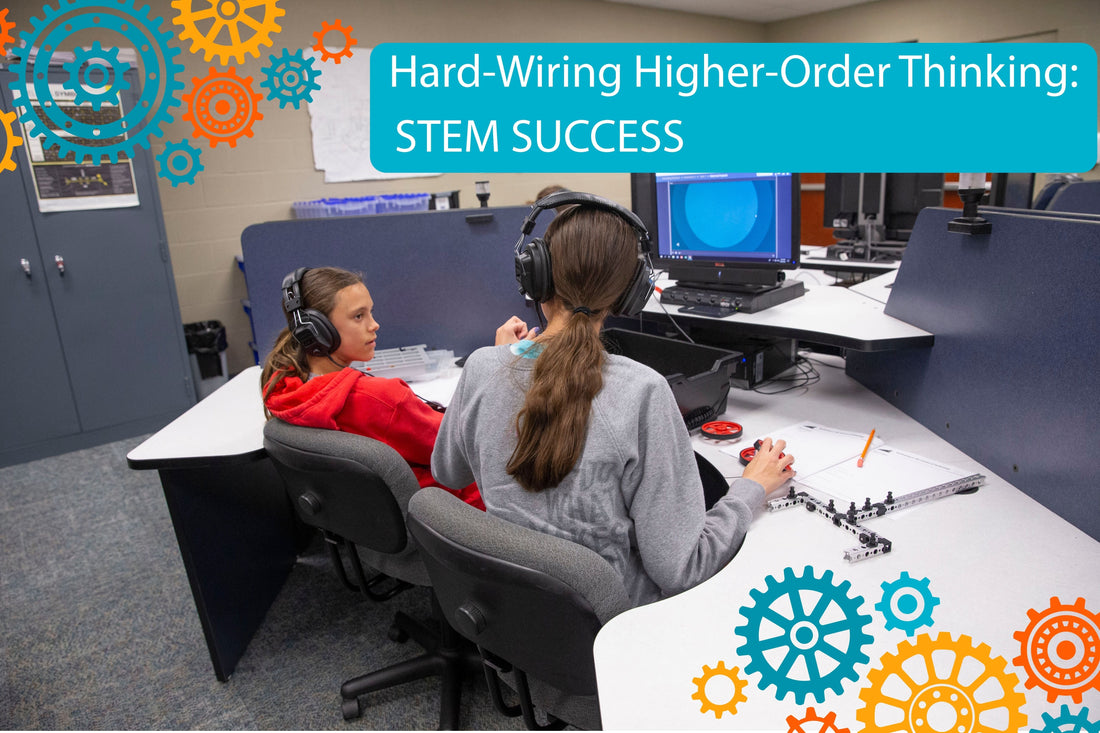Walk into Lynette Personett’s classroom at Mountain Ridge Middle School and you’ll find more than just swivel chairs and rocket parts—you’ll see students thinking like engineers, collaborating like professionals, and solving problems that don’t have obvious answers, all while taking the lead in their own learning.
That kind of independence is still rare. Despite expanded access to technology, many middle schoolers are still struggling to direct their own learning, advocate for themselves, and take responsibility for their education—gaps that teachers and principals across the country are reporting more frequently. But in Lynette’s class, students are learning how to do all of that and more.
With the help of Pitsco’s Expeditions—a hands-on program that blends digital research with real-world challenges—her students are building confidence, working through setbacks, and staying engaged from start to finish. And that’s exactly the kind of growth research supports. According to the National Library of Medicine, academic achievement rises when schools also address students’ social, emotional, and physical needs. When kids feel capable and motivated, deeper learning follows—and in Lynette’s lab, that’s exactly what’s happening.

On an Expedition to Opportunity
Lynette Personett’s classroom doesn’t look or feel like a typical middle school lab—and that’s the point. Students move between sleek computer stations and hands-on project kits, immersed in STEM challenges that feel more like real-world problem-solving than traditional lessons. One student might be testing dragster designs to explore aerodynamics, while another maps out the energy transfer of a roller coaster—all through Pitsco’s Expeditions program, designed to blend hands-on learning, digital research, and student-driven inquiry into a single experience.
But giving students that kind of autonomy has revealed something deeper—many aren’t just new to STEM, they’re missing the foundational skills that make independent learning possible. Lynette quickly saw that some students hadn’t been introduced to core concepts like the metric system, and more often than not, they didn’t know how to begin without someone walking them through it.
“At first, there was a bit of learned helplessness,” Lynette explains, “but the kids stumble, then recognize patterns—and those patterns become habits. Even something as simple as learning to navigate the program’s system is an essential skill for their future.”
Rather than stepping in too quickly, Lynette gives her students room to figure things out—because the goal isn’t just to finish a task, it’s to learn how to push through it. Over time, those early stumbles start turning into breakthroughs, and students begin to manage their own progress, take initiative, and approach each station with more focus and confidence.
And it’s not happening in a vacuum. Just down the road, their future high school is home to a nationally recognized STEM program, with a TSA team that’s won awards at the highest level and a newly funded $100,000 classroom renovation. For Lynette’s students, the pipeline is real—and the preparation starts now.

Supporting Skills for a Lifetime of Success
Every part of the Expeditions experience is designed to stretch students in ways that feel relevant. They’re not just building models or running experiments—they’re managing timelines, adapting when things don’t go as planned, and learning how to move forward without starting over. If a station takes longer than expected, they’re the ones responsible for asking for an extension, identifying the hold-up, and resetting their goals.
That level of responsibility doesn’t come from strict instructions—it comes from the structure Lynette sets and the freedom she gives students to navigate it. While she provides the framework, the learning is in their hands. They’re expected to stay focused, make decisions, and work alongside classmates who might approach things completely differently. In the process, they’re building habits that mirror what success looks like outside of school—managing time, communicating clearly, and making thoughtful choices when things don’t go perfectly.
These aren’t just helpful classroom behaviors—they’re foundational skills that shape how students grow into capable, resilient adults. According to LinkedIn’s “Global Talent Trends” report, 91% of talent professionals see social-emotional learning as more important to the future of work than any other trend. Self-management, collaboration, and confidence aren’t just nice to have—they’re expected.
Lynette bakes those opportunities into her class by design. She intentionally pairs students with peers outside their social circles, encouraging them to find common ground, adapt their communication styles, and recognize different strengths. In a setting like Expeditions, where teamwork directly impacts focus and efficiency, these interactions make the learning deeper and the outcomes more meaningful—especially when students have the space to reflect on how they got there and what they learned along the way.

One Step at a Time
On the first day of class, some of Lynette’s students didn’t know how to turn on a computer—but none of them yet realized what they could achieve. In the weeks since, they’ve learned to do more than they thought possible: using dual screens to study and take notes; organizing scientific steps from data collection to justified conclusions; even correcting their own logbooks, turning scribbles into clear, grammatically correct sentences. Wherever students begin, every step toward independent thinking is a step in the right direction. With skills like adaptability, effective planning, self-awareness, and teamwork, these kids are heading toward a richer tomorrow—no matter where tomorrow takes them.
Ready to immerse your students in full body learning? Explore STREAM Missions and Expeditions, plus, the set-up that transforms any space into an environment built for focus and discovery. For even more intentional SEL practice, pair Pitsco’s age-appropriate, hands-on STREAM resources with a MicroBurst Learning lesson—bringing ten categories of EmployABILITY soft skills to your students in STEM and career contexts.

